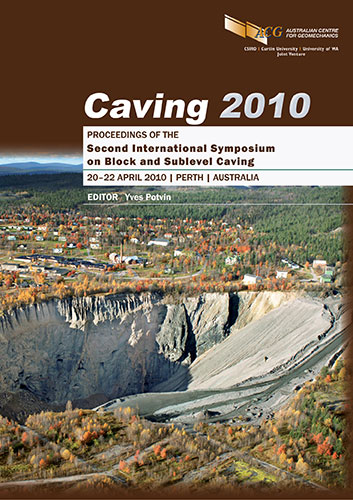Geotechnical characterisation — Cadia East panel caving project, New South Wales, Australia

|
Authors: Catalan, A; Suarez, C |
DOI https://doi.org/10.36487/ACG_rep/1002_26_Catalan1
Cite As:
Catalan, A & Suarez, C 2010, 'Geotechnical characterisation — Cadia East panel caving project, New South Wales, Australia', in Y Potvin (ed.), Caving 2010: Proceedings of the Second International Symposium on Block and Sublevel Caving, Australian Centre for Geomechanics, Perth, pp. 371-387, https://doi.org/10.36487/ACG_rep/1002_26_Catalan1
Abstract:
The geotechnical and structural characterisation of the rock mass is a fundamental tool for the development of any mining project. This knowledge allows the generation of reliable models capable of representing anticipated geotechnical conditions of caving processes and for prediction of probable behaviour at distinct depths and geometries. Cadia East underground project will be one of the largest and deepest panel caving operations in Australia. The first extraction level will be situated about 1,200 m below surface and a second lift located about 1,400 m shall be brought into operation simultaneously with the first lift. It has dimensions over 250 m wide, with a strike length in excess of 1,200 m and a vertical extent of 800 m could classify this orebody as a world-class mining project. Due to these characteristics, during to the last five years extensive and careful geological, metallurgical and geotechnical studies have been carried out mainly based on more than 400 km of drillholes and about 900 m of bulk sample drive. This paper will describe the geotechnical process which has been implemented at Cadia East project and how geological and geotechnical information has been assembled and implemented in a powerful geotechnical platform. This structure has incorporated a robust geotechnical database which includes lithologies, alterations, structural condition and geotechnical rock mass characterisation, allowing for the development of a 3D geotechnical model. Also and from these sources, the critical geotechnical parameters have be derived for use in assessing rock mass quality through standard classification methodologies such as rock mass rating (RMR) and mining rock mass rating (MRMR) or the geological strength index (GSI). Finally, this geotechnical process has added an adequate level of belief in order to support all necessary geotechnical studies that support the prefeasibility phase of what will become the largest and deepest panel cave in Australia.
References:
Barton, N., Lien, R. and Lunde, J. (1974) Engineering classification of rock masses for the design of tunnel support, Rock Mechanics, Vol. 6(4), pp. 189–236.
Bieniawski, Z.T. (1989) Engineering Rock Mass Classifications, Wiley, New York, 251 p.
Catalan, A., Suarez, C., Barrera, V. and Qudraturrahman, I. (2008) Cadia East Underground Project Prefeasibility Study, Geotechnical Report, Newcrest Mining Limited, internal document.
Finn, D.J. (2006) Late Stage Phyllic Alteration in the Cadia East Copper-Gold Porphyry Deposit NSW, Implications to Mineralisation, Bachelor Degree Thesis, University of Tasmania.
Hoek, E. (1994) Strength of rock and rock masses, News Journal International Society of Rock Mechanics, Vol. 2(2), pp. 4–16.
Hoek, E., Carranza-Torres, C. and Corkun, B. (2002) Hoek-Brown Failure Criterion – 2002 Edition, in Proceedings 5th North American Rock Mechanics Symposium, University of Toronto Press.
Holliday, J.R., Wilson, A.J., Blevin, P.L., Tedder, I.J., Dunham, P.D. and Pfitzner, M. (2002) Porphyry gold-copper mineralisation in the Cadia District, eastern Lachlan fold belt, New South Wales, and its relationship to shoshonitic magmatism, Mineralium Deposita, Vol. 37, pp. 100–116.
Hulls, I., Smith, J. and Walton, R. (2008) Cadia East stress measurements, Coffey Mining Pty Ltd, report submitted to Newcrest Mining Limited.
Kitto, J.C. (2005) Lithostratigraphy, alteration and geochemistry at the Cadia gold-copper porphyry deposit, NSW, BSc Thesis, University of Tasmania.
Laubscher, D.H. (1990) A geomechanics classification system for the rating of rock mass in mine design, Journal of the South African Institute of Mining and Metallurgy, Vol. 90, No. 10.
Marinos, P. and Hoek, E. (2000) GSI: a geologically friendly tool for rock mass strength estimation, in Proceedings GeoEng2000, International Conference on Geotechnical and Geological Engineering, Melbourne, Technomic publishers, Lancaster, pp. 1422–1446.
Squire, R.J. (2001) Volcanological and tectono-magmatic evolution of the Cadia-Neville region, Unpublished PhD Thesis, University of Tasmania.
Wilson, A.J. (2003) The geology, genesis and exploration context of the Cadia gold-copper porphyry deposits, New South Wales, Australia, PhD Thesis, University of Tasmania.
© Copyright 2025, Australian Centre for Geomechanics (ACG), The University of Western Australia. All rights reserved.
View copyright/legal information
Please direct any queries or error reports to repository-acg@uwa.edu.au
View copyright/legal information
Please direct any queries or error reports to repository-acg@uwa.edu.au